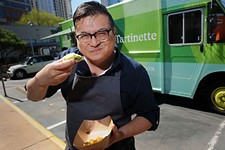It's a Flaky, Gooey, Crusty, Sugary, Savory Morning
Fri., June 3, 2005
Kolaches
"Basically, they're dough with stuff in it," observes Dawn Orsak, Czech-Texan and Czech food expert. "Almost every culture has some variation of that." That said, however, Orsak (coordinator of the Saveur Texas Hill Country Wine & Food Festival) has perused hundreds of recipe variations and can specifically describe just what makes a good kolach. (And take note, people: In Czech, kolach is singular and kolache is plural. The common Americanism "kolaches" is a linguistic redundancy.)
Composed of soft, light, slightly sweet, elastic, yeasty dough surrounding a generous well of fruit paste, cheese, or sausage, kolache are a beloved element of Central Texas foodways, ever since the first Czech settlement in the mid-19th century. By the 20th century, there were 250 Czech communities in Texas, particularly in the Blackland Prairie farm belt east of Austin. Many of these towns still thrive, working hard to preserve Czech heritage through cultural and history centers, festivals and, of course, kolach cookoffs. For kolach fanatics en route to Dallas or Houston, there are several legendary "Czech stops," including Hruska's in Ellinger, Weikel's in La Grange, and at least three in tiny West on I-35.
Prune, poppy seed, and sweetened cheese are the classic fillings brought from Europe, but Alena Reznickova-Jimenez, Czech Republic native and now Texan-by-marriage, finds the dough a bit different here (probably due to wheat varieties and flour-production methods), and she never saw klobasnik (Czech pork sausage) in a kolach until she came to Austin. Is this popular Texas treat a New World innovation or simply a Czech regional variation? Orsak notes that most Czech-Texan families originated in Moravia near the Polish border, and that may explain the difference.
Speaking of innovation, these days it seems that just about anything goes to fill a kolach: The traditional yeast dough is a vehicle for a huge variety of flavors, both sweet and savory. At Austin's oldest emporium, the Kolache Shoppe (7113 Burnet, 458-5542, www.kolacheshop.com), owner-baker Robert Ahrens has been making 25 varieties for 25 years. In addition to the classics, some of his more unusual variations include bacon, meatball, and pineapple.
In his cheerfully painted, often flower-bedecked new shop in South Austin, Steve Frederick's Big Kolache (2407-A S. Congress, 383-9050) bakes 16 varieties. Sweet fillings are made from scratch (Maine blueberry is especially decadent), and he uses smoky Elgin hotlinks for the wrapped sausage selections.
In the central city, Massey Wallace recently stopped being a UT engineer and, at the urging of family and friends, opened Lone Star Kolaches (3800 N. Lamar, 323-3663, www.lonestarkolaches.com). In addition to a respectable variety of traditional flavors, Wallace carries innovation to the extreme in some of her 30 selections, offering such anomalies as broccoli/egg/cheese, Tuscany chicken, and barbecue beef.
At the opposite end of the spectrum, the European Bistro restaurant and bakery in Pflugerville (111 E. Main, 512/835-1919, www.hungariancatering.com) offers a mere five fillings – strawberry, apricot, cheese, sausage, ham/cheese – but like all their traditional Eastern European desserts, they are exquisite.
It's a beautiful thing that Austin neighborhoods have gotcha kolache covered, but be aware that a kolach is best eaten very fresh. Once baked, kolach dough does not age gracefully, so the earlier you arrive, the softer, more fragrant, and flavorful your kolach will be. – MM Pack








